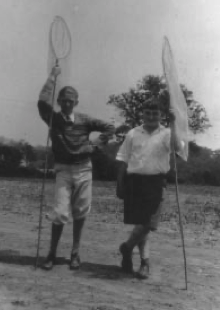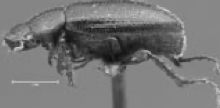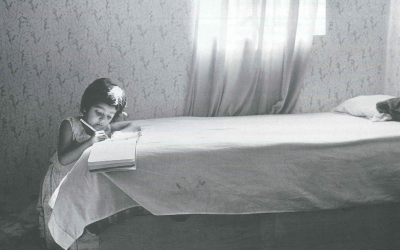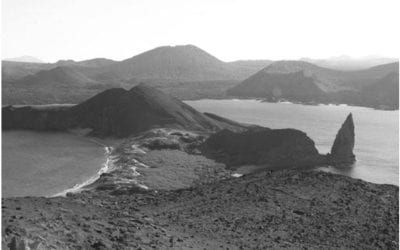On The David Rockefeller Collection of Coleoptera (Beetles)
On a warm August 30 in Roslyn, NY in the year 1922, a brave seven-year-old David Rockefeller picked up an inch long brown beetle with fearsome pinching mandibles and plunged it into a jar to bring home. That specimen ofParandra brunneus would become the first of some 90,000 beetles in the Rockefeller collection of Coleoptera, today housed in hundreds of speciallymade, airtight, hardwood boxes kept in the wall of cabinets at his residence in Pocantico Hills.
I have seen the collection many times, and consulted the excellent technical library kept close at hand, in visits to Mr. Rockefeller. My former graduate student, beetle expert Geoff Morse, has also spent innumerable hours cataloging the collection in a database that will be online, with high resolution images of every species, when it arrives one day at its permanent home in the Museum of Comparative Zoology at Harvard.
David Rockefeller knows beetles. On our first meeting at Harvard in 1998 (we were introduced by his daughter Eileen, whom I first met as a Vermont neighbor some 20 years earlier), I walked with David through the exhibit of beetles just opened in the Harvard Museum of Natural History, and his breadth of familiarity with the taxonomy of the many hundreds of specimens on display was astonishing, if not unpredictable. Sixtysix years earlier, young David received an A as a freshman at Harvard (the only A grade the young economics concentrator at Harvard would earn, he likes to say) in the graduate level entomology course taught by one of my predecessors, Frank Carpenter (a course I now offer, see pp. 6-10). President Lowell first brought David Rockefeller to the MCZ in his last year of office, and the two enjoyed lunch with the expansive MCZ director, Dr. Thomas Barbour. The “Eateria” founded by Barbour was a lunch venue in his MCZ office that occasionally featured fresh terrapin brought up from tanks in the MCZ basement, and the list of attendees over the Eateria history from 1932-1946 is a who’s who of science, letters and international affairs.
Over the 80-plus years since collecting that first beetle, David Rockefeller has continued to build his collection in the ways great collections are always built-personal effort, supporting the expeditions of others in return for a portion of the catch, and being always alert to the rare collections that come up for sale. David Rockefeller has particularly fond memories of participating in a now-famous expedition down into the Grand Canyon, studying the altitudinal zonation of plant and insect life that changes with the descent in ways that parallel the biotic changes with latitude from northern Arizona into southern Mexico. David sponsored many other expeditions, especially to Mexico, founded the Southwestern Research Station in the Chiricahua Mountains of Arizona, and supported entomologists in Brazil and elsewhere for collecting.
Constancy of interest is revealed in his collection. For example, on the very day he turned 16, a milestone for any young American boy, young David found time for collecting-at Pocantico Hills that day he captured eight species of leaf-beetles and two scarabs. David remained very much a beetle man during his World War II stint from 1943-1944 in North Africa during which he captured in Algeria some 131 beetle specimens representing 41 species. Allied success of course permitted an eventual inspection of the new grape crop at the Chateau Lascombes, in the Medoc on the 5th of July 1956, where David spied and seized the longhorned beetle Caloclytus varius. A later family trip to the Firestone rubber plantations in Liberia similarly resulted in a fine series of rhinoceros beetles, Augosoma centaurus. In short, a biography not captured in his memoirs is written in tiny script on the thousands of labeled beetles in the Ro efeller collection of beetles.
David Rockefeller has more than a dozen insect species named for him, based on previously unknown species that were first collected by him per son ally or on the expeditions he sponsore One such beetle is the rare Mexican high altitude scarabDiplotaxis rockefelleri pictured above. These expeditions have resulted so far in the discovery of over 150 new species, represented by the scientifically important type specimens in his collections, though many more new species are likely to be discovered as international experts who visit the MCZ collections study the material.
With Geoff about a quarter through the database of his collection, the tally shows Rockefeller has personally collected at least 500 species (approximately 10% of the specimens) from 23 different countries (Algeria, Austria, Brazil, Ecuador, France, French West Indies, Greece, India, Israel, Italy, Kenya, Liberia, Mexico, Peru, South Africa, Spain, Tanzania, Trinidad & Tobago, Tunisia, the USA, Venezuela and Zimbabwe), in every decade since the 1920s. The Rockefeller collections very heavily favor five of the most diverse (and attractive) beetle families, the predatory ground beetles in the family Carabidae, the dung-beetles and June beetles in the family Scarabaeidae, the woodboring beetles in the familiesBuprestidae and Cerambycidae and the leaf-beetles in the Chrysomelidae, and total over 9,000 species in all.
On a recent visit to his farm in Maine, my wife Irina and I accompanied David as he directed clearing of several broken trees that were also blocking the view, when a large cerambycid beetle flew in and out over a 30 foot drop. David was fixed on the beetle, and it was certain that one of us would be going over the brink for it, had I not realized in time that his collection already had this species of pine sawyer beetle, Monochamus scutellatus. In fact, the pine sawyer in the Rockefeller collection was obtained exactly 115 years earlier in Auburn, Maine on the 1st of September 1889 (this is not the oldest specimen in his collection, a distinction that belongs to the six-spotted tiger beetle, Cicindela sexguttata, collected from the same site in 1884).
David Rockefeller continues to build his important collection of beetles, with expeditions to tropical countries, often accompanied by Geoff Morse, in pursuit of this oldest of his interests. As a beetle collector, he is in good company with fellow beetle collectors Charles Darwin and Sir Alfred Russell Wallace, who together presented their independent conceptions of the theory of natural selection as an agent of evolution to the Linnaean Society in London. While their British collections are housed at Oxford University, Rockefeller’s much larger collections will be the centerpiece of the mounting revolution in museum collections being led by the MCZ- high resolution digital images and data freely available online to the countries from which the specimens came. In keeping with the spirit of the DRCLAS, and globalization, this building of an international network of information on biodiversity strengthens every participant. David Rockefeller’s extraordinary collection of beetles will serve as an influential, international model for the digital age of natural history collections, a contribution with elements of many of the scholarly, international and aesthetic enterprises with which the Rockefellers have been so long associated.
Fall 2004/Winter 2005, Volume III, Number 1
Brian D. Farrellis a Harvard Professor of Biology and Curator in Entomology.
Related Articles
Editor’s Letter: Flora and Fauna
Ellen Schneider’s description of Sandinista leader Daniel Ortega in her provocative article on Nicaraguan democracy sent me scurrying to my oversized scrapbooks of newspaper articles. I wanted to show her that rather than being perceived as a caudillo
Bilingual Aesthetics: A New Sentimental Education
After an exhausting game of soccer with a crew of Mexico City street children, Vicente, a young teenager of 13 said, “Vamonos a la verga.” It was my third day with Casa Alianza, the international…
Nature and Citizenship
Two first-time visitors to the Galapagos archipelago begin their experience in exactly the same way. Two hours after departing mainland Ecuador, their plane descends towards the island of…






